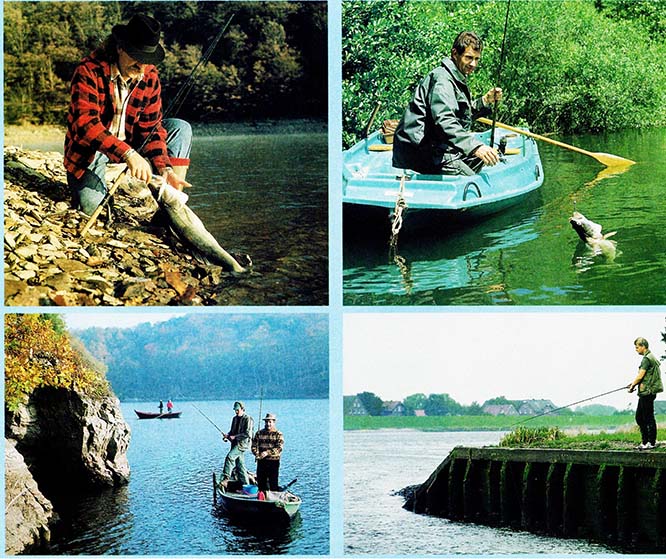 Szkliste oczy są czujne! Wraz ze wzrostem popularności łowienia sandaczy coraz więcej wędkarzy zadaje sobie pytanie – gdzie dzisiaj żerują te ryby? Ulrich próbuje udzielić odpowiedzi.
Szkliste oczy są czujne! Wraz ze wzrostem popularności łowienia sandaczy coraz więcej wędkarzy zadaje sobie pytanie – gdzie dzisiaj żerują te ryby? Ulrich próbuje udzielić odpowiedzi.
Łowienie sandaczy jest bardzo przyjemne – pod warunkiem jednak, że najpierw uda się je zlokalizować. Drapieżniki te prowadzą bowiem bardzo skryty tryb życia i znalezienie ich w łowisku nie jest wcale takie łatwe, jak na przykład polującego tuż pod powierzchnią wody szczupaka. Jeżeli jednego dnia sandacze doskonale brały w jakimś miejscu. za jakiś czas może okazać się, że są już zupełnie gdzie indziej. W związku z tym łowienie sandaczy wiąże się z ciągłym i bardzo systematycznym szukaniem ryb, gdyż jest to jedyny sposób na odniesienie sukcesu.
Bardzo dobrymi łowiskami sandaczy są duże uregulowane rzeki oraz jeziora zaporowe, słowem wody w znacznym stopniu ukształtowane ręką człowieka. Łowiska te charakteryzują się przeważnie dużą głębokością, monotonią, niewielką ilością roślinności oraz znacznym stopniem zmętnienia wody. W dobrych sandaczowych łowiskach często występują także ładne szczupaki.
Wędkarz pragnący odnosić sukcesy musi najpierw bardzo dobrze poznać swoje łowisko oraz zwyczaje i sposób życia sandaczy.
Ławice małży
Ogólnie wszystkim wiadomo jest, że sandacze lubią twarde dno, najlepiej z rozległymi ławicami małży. Przyczyna takich upodobań widoczna jest jak na dłoni. Tam, gdzie tworzą się olbrzymie kolonie maleńkich małży, gromadzą się także duże ilości płoci odżywiających się jednorocznymi i dwuletnimi małżami. Drobne płocie natomiast zajmują bardzo ważną pozycję w jadłospisie sandaczy.
W wodzie płynącej drapieżnik ten często poluje także na granicy nurtu. Tam, gdzie silny prąd styka się ze stojącą prawie wodą, na dnie odkłada się niesione przez rzekę pożywienie białych ryb. Suto nakryty stół z magiczną siłą przyciąga drobnicę, na którą zawzięcie polują sandacze. Drapieżniki te lubią też, podobnie zresztą jak spokrewnione z nimi okonie, gromadzić się w pobliżu zatopionych drzew. Leżące na dnie gałęzie i pnie zasłaniają przed światłem, gwarantują idealne kryjówki i dużą ilość pokarmu. Tuż za zawadami załamuje się bowiem prąd wody, na dnie odkładają się drobinki pokarmu naturalnego, a to z kolei od razu przyciąga drobnicę.
Unikanie światła
Sandacze unikają dobrze nasłonecznionych miejsc, więc na brania należy liczyć raczej w przycienionych, choć niekoniecznie bardzo głębokich partiach wody. Podczas łowienia sandaczy oświetlenie wody odgrywa więc bardzo ważną rolę. Drapieżników tych należy szukać tam, gdzie woda nie jest zbyt oświetlona, a sandacze znajdują korzystne warunki bytowe. W ciągu dnia bardzo obiecujące są więc miejsca ocienione drzewami lub kadłubami zacumowanych łodzi, brań należy się spodziewać także pod mostami. Mętna woda w rzece lub w jeziorach powyrobiskowych również rokuje udany połów.
W upalne dni
Nie oznacza to, że łowienie w słoneczny dzień skazane jest na niepowodzenie. Sandacze żerują także w samo południe – czasami jednak w innych miejscach niż zwykle. Mojego największego sandacza złowiłem w bardzo upalny letni dzień, dosłownie metr pod powierzchnią.
Łowisko w tym miejscu było bardzo głębokie, a woda mętna jak kawa z mlekiem. Wszystko na to wskazuje, że takie warunki bardzo odpowiadają szklistookim sandaczom.
Niestety wędkarz bardzo często nie jest w stanie wytypować wielu dobrych łowisk sandaczy. Chcąc mimo wszystko odnosić sukcesy, ryb tych należy po prostu poszukać. W zależności od chęci, doświadczenia i ilości łowiących wspólnie wędkarzy, istnieje wiele różnych metod systematycznego sprawdzania łowiska. Bardzo szybko udaje się to za pomocą echosondy, niestety jednak tylko nieliczni koledzy posługują się na co dzień tym jakże przydatnym urządzeniem.
Sondowanie
Systematyczne sondowanie ciężarkiem interesujących partii wody jest już o wiele bardziej czasochłonne. W kanałach (bardzo dobre łowiska sandaczy!) można na przykład wysondować atrakcyjnie zapowiadające się miejsca nawet podczas relaksowego rekonesansu nad wodą. Wystarczy tylko zabrać ze sobą lekką wędkę odległościową oraz kilka ciężarków. Bardzo skrupulatni wędkarze wykonują przy tym dokładne notatki, nanoszą na szkicach charakterystyczne punkty na brzegu, zaznaczają wszystkie dołki, wypłycenia i spadki dna kanału lub rzeki.
Jeżeli ktoś pragnie poświęcić więcej uwagi wyjątkowo obiecującemu odcinkowi, może zabrać ze sobą na rekonesans lekki spinning i przetestować to miejsce twisterem. Ostrzegam jednak, że potrzebne jest do tego spore doświadczenie. Wędkarz musi mieć idealne wyczucie w rękach, aby bezbłędnie wyczuć ukształtowanie dna, a przy okazji szczęśliwie omijać większość zawad pojawiających się na drodze przynęty.
Największą zaletą tej metody jest jednak to, że przy odrobinie szczęścia można mieć brania już podczas pierwszej wyprawy nad nieznaną wodę. Ciężarkiem poznaje się tylko ukształtowanie dna i głębokość łowiska, twisterem dokładnie to samo, a przy okazji łowi się także ryby.
W krzyżowym ogniu
Sandacze nie zawsze biorą na przynęty sztuczne. Czasami interesują się tylko przynętami naturalnymi. Wtedy najlepszym rozwiązaniem jest wspólne szukanie dobrych miejsc razem z kilkoma kolegami i wzięcie drapieżników w „krzyżowy ogień przynęt”. Sprawdzony zestaw z przynętą naturalną zarzuca się w jedno miejsce na dziesięć minut i jeżeli nic się nie dzieje, należy powoli zwinąć zestaw (uwaga, branie ciągle jest możliwe) i przerzucić go około dwudziestu metrów dalej. Kilku współpracujących ze sobą kolegów potrafi w ten sposób bardzo szybko przetestować nawet dość długi odcinek rzeki lub kanału. Miejscom, w których biorą sandacze należy oczywiście poświęcić znacznie więcej uwagi.
Na chybcika
Jeżeli ktoś nie ma ani czasu ani ochoty systematycznie sprawdzać łowisko. to istnieją dwie możliwości „nawiązania kontaktu’’ z sandaczami. Można na przykład skoncentrować się na miejscach, w których inni wędkarze łowią duże ilości białych ryb. Tam, gdzie jest drobnica, w pobliżu powinny być także sandacze.
Druga możliwość polega na znalezieniu obiecującego sandaczowego miejsca i zwabieniu tam drapieżników, również na dwa dowolne sposoby. Można nęcić tylko panierką i zwabić w ten sposób drobnicę, a za nią sandacze albo nęcić panierką i małymi martwymi rybami lub kawałkami ryb i zwabić zarówno sandacze, jak i drobnicę. Im dłuższy okres nęcenia, tym lepiej…